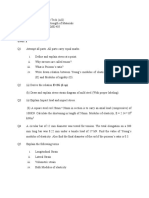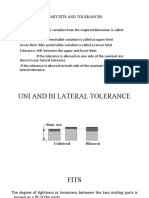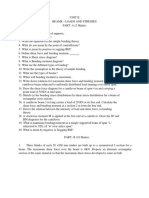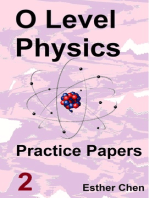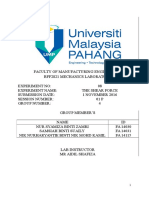ME1402A QB Som
ME1402A QB Som
Uploaded by
deva290605Copyright:
Available Formats
ME1402A QB Som
ME1402A QB Som
Uploaded by
deva290605Original Title
Copyright
Available Formats
Share this document
Did you find this document useful?
Is this content inappropriate?
Copyright:
Available Formats
ME1402A QB Som
ME1402A QB Som
Uploaded by
deva290605Copyright:
Available Formats
ME1402A-STRENGTH OF MATERIALS
QUESTION BANK
PART – A
State Hooks law.
1. Hooke's Law states that stress is directly proportional to the strain within
the elastic limit of the material.
Define stress and strain.
Stress refers to the internal force per unit area within a material that
2. develops in response to an external force applied to the material.
It is defined as the ratio of the change in dimension (such as length, area,
or volume) to the original dimension of the material.
Define principal plane and principal stresses.
The plane which is having only normal stress and zero shear stress is
called principal plane.
3.
Principal stress refers to the maximum and minimum normal stresses
experienced by a material at a particular point under given loading
conditions.
Define Poisson’s Ratio.
4. Poisson's ratio is a measure of the ratio of lateral strain to longitudinal
strain in the direction perpendicular to the applied load
Discuss about thermal stresses.
Thermal stresses occur in materials when there are variations in
5. temperature throughout the material or between different parts of a
structure. These temperature variations can lead to changes in
dimensions, which in turn induce stresses within the material.
Define point of contra-flexure.
A point of contraflexure in a beam is where the bending moment
6.
changes sign, marking the transition from sagging to hogging (or vice
versa) curvature.
Discuss the assumptions in theory of simple bending.
i) The material of the beam is homogeneous and isotropic,
7. meaning its mechanical properties are uniform in all directions.
ii) The stress-strain relationship follows Hooke's Law, meaning
stress is directly proportional to strain within the elastic limit.
Summarize and sketch the types of supports used for a beam indicating
8. the reactions in each case.
Refer Class Notes
List out the types of beams.
1.Cantilever beam
2.Simply supported beam
9.
3.Overhanging beam
4.Fixed beam
5.Continuous beam
Define sagging and Hogging.
Sagging, also known as concave upward bending, occurs when the
beam's deflection causes the top surface of the beam to curve upward
and the bottom surface to curve downward.
10.
Hogging, also known as concave downward bending, occurs when the
beam's deflection causes the top surface of the beam to curve downward
and the bottom surface to curve upward.
11. Define torsional rigidity.
Torsional rigidity, also known as torsional stiffness or rotational
stiffness, refers to the resistance of a structural member or component
to twisting deformation when subjected to a twisting moment or torque.
Explain about twisting moment.
Twisting moment, also known as torque or torsional moment, is a
12.
rotational force applied to an object that tends to cause it to rotate around
an axis.
Explain why hollow circular shafts are preferred over solid circular
shafts.
13.
Hollow shaft helps to reduce weight results in material saving, cost
reduction e.t.c.
Distinguish open coiled and closely coiled helical springs.
Open-Coiled Helical Springs there is a significant gap or space between
14. adjacent coils. It is useful in compressive load
Closely-coiled helical springs, on the other hand, have minimal or no
gap between adjacent coils. It is useful in tensile load.
State maxwell’s reciprocal theorems.
The work done by the first system of loads due to displacements caused
15.
by a second system of loads equals the work done by the second system
of loads due to displacements caused by the first system of loads.
Define strain energy.
16. Strain energy is a form of potential energy that is stored within a material
when it undergoes deformation due to applied loads.
List the limitations of double integration method.
Not suitable for beams with variable cross-sections: The double
17. integration method assumes that the beam has a constant cross-section.
For beams with variable cross-sections, such as tapered beams, the
method cannot be used.
List the methods of determining slope and deflection at a section in a
loaded beam.
i)Double Integration method
18.
ii)Macaulay’s Method
iii)Conjugate beam method
iv)Moment Area Method
State Lame’s Theorem.
Lame's theory for thick cylinders states that in a thick-walled cylinder
19.
subjected to internal or external pressure, the stresses vary radially and
tangentially across the thickness of the cylinder.
Distinguish between a thin cylinder and a thick cylinder.
Thin cylinder wall thickness is less than 1/20th of its internal diameter
20.
of cylinder whereas thick cylinder wall thickness is more than 1/20th of
internal diameter of cylinder.
Define hoop stress and longitudinal stress.
Hoop stress, also known as circumferential stress, is the stress
21. experienced circumferentially around the circumference of a cylinder.
Longitudinal stress, also known as axial stress, is the stress experienced
along the longitudinal axis of a cylinder.
State the stresses developed in the cylinder.
i. Hoop Stress
22. ii.Longitudinal Stress
iii.Radial Stress
iv.Shear stress
PART B & C
A member ABCD is subjected to point loads P1, P2, P3 and P4 as shown
in figure. Calculate the force P2 necessary for equilibrium, if P1=45KN,
1.
P3=450KN and P4=130KN. Compute the total elongation of the
member, assuming the modulus of elasticity to be 2.1x105 N/mm2.
An axial pull of 35000 N is acting on a bar consisting of three lengths
as shown in figure. If the Young’s modulus is taken as 2.1x105 N/mm2
, Calculte: (i) Stresses in each section and (ii) Total extension of the bar.
2.
A cantilever 1.5m long is loaded with a uniformly distributed load of
2KN/m run over a length of 1.25m from the free end. It also carries a
3.
point load of 3KN at a distance of 0.25m from the free end. Sketch the
shear force and bending moment diagrams of the cantilever.
A Simply Supported beam of length 6m carries point load of 3kN and 6
4. kN at a distance of 2m and 4 m from the left end. Sketch the shear force
and bending moment diagrams of the beam.
5. Two shafts of the same material and of same lengths are subjected to the
same torque, if the shaft is of a solid circular section and the second shaft
is of hollow circular section, whose internal diameter is 2/3 of the
outside diameter and the maximum shear stress developed in each shaft
is the same, compare the weight of shafts.
6. A hollow shaft is to transmit 300 kW power at 80 r.p.m. If the shear
stress is not to exceed 60 N/mm2 and the internal diameter is 0.6 of the
external diameter, Calculate the external and internal diameters
assuming that the maximum torque is 1.4 times mean.
7. Cantilever of length l carrying uniformly distributed load w kN per unit
over whole length. Calculate the slope and deflection at the free end by
double integration method.
8. A simply supported beam subjected to uniformly distributed load of w
kN/m for the entire span. Calculate the maximum deflection by double
integration method.
9. A cylindrical thin drum 80 cm in diameter and 3 m long has a shell
thickness of 1 cm. if the drum is subjected to an internal pressure of 2.5
N/mm2, Calculate
(i) Change in diameter
(ii) Change in length
(iii) Change in volume.
Take E = 2x 105 N/mm2, Poisson’s ratio = 0.25
10. Calculate: (i) the change in diameter, (ii) change in length and (iii)
change in volume of a thin cylindrical shell 100 cm diameter,1 cm thick
and 5 m long when subjected to internal pressure of 3N/mm2.Take the
value of E = 2 x 105 N/mm2 and Poisson’s Ratio, µ =0.3.
11. A simply supported beam of length 5 m carries a point load of 5kN at a
distance of 3m from the left end. If E=2x 105 N/mm2 and I = 108 mm4,
determine the slope at the left support and deflection under the point
load using conjugate beam method.
12. At a point within a body subjected to two mutually perpendicular
directions, the tensile stresses are 80 N/mm2 and 40 N/mm2 respectively.
Each stress is accompanied by a shear stress of 60 N/mm2. Analyze the
normal stress, shear stress and resultant stress on an oblique plane
inclined at an angle of 450 with the axis of minor tensile stress.
13. A bar of 30 mm diameter is subjected to a pull of 60 KN. The measured
extension on gauge length of 200 mm is 0.1 mm and change in diameter
is 0.004 mm. Calculate:
(i) Young’s modulus
(ii) Poisson’s ratio and
(iii) Bulk modulus.
14. A steel tube of 30mm external diameter and 20mm internal diameter
encloses a copper rod of 15.5mm diameter to which it is rigidly joined
at each end. If, at a temperature of 10 oC there is no longitudinal stress,
Calculate the stresses in the rod and the tube when the temperature is
raised to 200 o C. Take Es = 2.1x105 N/mm2 and Ec = 1x105 N/mm2 Co-
efficient of linear expansion 11x10-6 per o C and 18x10-6 per o C.
15. A hollow shaft having an inside diameter 60% of its outer diameter is to
replace a solid shaft transmitting the same power at the same speed.
Calculate the percentage saving in material ,if the material to be used is
also the same.
16. A timber beam of rectangular section is to support a load of 20KN
uniformly distributed over a span of 3.6m when beam is simply
supported. If the depth of section is to be twice the breadth, and the
stress in the timber is not to exceed 7N/mm2, Calculate the dimensions
of the cross-section.
17. A closely coiled helical spring made of 10 mm diameter steel wire has
15 coils of 100 mm mean diameter. The Spring is subjected to an axial
load of 100 N.
Calculate:
i)The Maximum shear stress induced
ii) The deflection and
iii) Stiffness of the spring
Take modulus of rigidity = 8.16 x 104 N/mm2
18. Determine the maximum and minimum hoop stress across the section of
a pipe of 400 mm internal diameter and 100 mm thick, when the pipe
contains a fluid at a pressure of 8 N/mm2. Also sketch the radial pressure
distribution and hoop stress distribution.
19. A beam of length 6 m is supported at its ends and carries two-point loads
of 48 kN and 40 kN at a distance of 1 m and 3 m respectively from the
left support as shown in Fig.
Using Macaulay’s method compute:
(i) Deflection under each load
(ii) Maximum deflection
Given E = 2x 105 N/mm2 and I = 85 x 106 mm4
20. A cantilever of length 3 m is carrying a point load of 50kN at a distance
of 2m from the fixed end. If I = 108 mm4 and E = 2x 105 N/mm2 ,
Calculate i) slope at the free end ii)Deflection at the free end.
21. A boiler is subjected to an internal steam pressure of 2N/mm2.The
thickness of boiler plate is 2.6 cm and permissible tensile stress is 120
N/mm2.Calculate the maximum diameter, when efficiency of
longitudinal joint is 90% and that of circumference point is 40%.
22. A spherical shell of internal diameter 0.9 m and of thickness 10 mm is
subjected to an internal pressure of 1.4 N/mm2 Calculate the increase in
diameter and increase in volume. Take E = 2x 105 N/mm2 and µ = 1/3.
23. A horizontal beam of uniform section and 7m long is simply supported
at its ends. The beam is subjected to a uniformly distributed load of 6
KN/m over a length of 3m from the left end and a concentrated load of
12 KN at 5 m from the left end. Determine the maximum deflection in
the beam using Macaulay’s method.
24. A steel rod of 3cm diameter is enclosed centrally in a hollow copper duo
of external diameter 5 cm and internal diameter of 4 cm. The composite
bar is then subjected to an axial pull of 45000 N. If the length of each
bar is equal to 15 cm, Determine:
(i) The stresses in the rod and tube
(ii) Load carried by each bar.
Take E for steel = 2.1 x 105 N/mm2 and for copper = 1.1 x 105 N/mm2.
You might also like
- (Cambridge University Press) Evolution of Phase Transitions - A Continuum Theory 1st Edition by Rohan Abeyaratne (2006)Document259 pages(Cambridge University Press) Evolution of Phase Transitions - A Continuum Theory 1st Edition by Rohan Abeyaratne (2006)cjp6124100% (2)
- Som Unit I 2 & 16 MarksDocument7 pagesSom Unit I 2 & 16 MarksSurjith Bharathi SelvakumarNo ratings yet
- 1 Chapter 1 StrenghtDocument37 pages1 Chapter 1 Strenghttest 2No ratings yet
- 24280Document24 pages24280sarul_murugan2483No ratings yet
- Question Bank Strength of MaterialDocument19 pagesQuestion Bank Strength of MaterialSanjay TiwariNo ratings yet
- QBDocument18 pagesQBMudrikaNo ratings yet
- SOM Question BankDocument9 pagesSOM Question Bankmohanmech2006886No ratings yet
- Ce6306 Strength of MaterialsDocument21 pagesCe6306 Strength of Materialsmithunarjun10108No ratings yet
- Questionbank SOM RejinpaulDocument13 pagesQuestionbank SOM Rejinpaularunmct04No ratings yet
- 075 - CE8301, CE6306 Strength of Materials I - Question BankDocument10 pages075 - CE8301, CE6306 Strength of Materials I - Question BankGERARD HAULENo ratings yet
- EE 602 - Mechanics of MaterialsDocument44 pagesEE 602 - Mechanics of MaterialsCtstrphyNo ratings yet
- MosDocument20 pagesMosutsav_koshtiNo ratings yet
- Mos QBDocument4 pagesMos QBJaishree ChauhanNo ratings yet
- Strength of Materials QB 2015Document10 pagesStrength of Materials QB 2015smg26thmayNo ratings yet
- Mechanics of SolidsDocument15 pagesMechanics of Solidsselva1975No ratings yet
- SOM Question BankDocument8 pagesSOM Question BankprakashmenmoliNo ratings yet
- Som Na (UBMCC09)Document13 pagesSom Na (UBMCC09)arjunguttula11No ratings yet
- Som Marine (UBMCC09)Document13 pagesSom Marine (UBMCC09)Sonu YadavNo ratings yet
- Strength of Materials QB 2015Document10 pagesStrength of Materials QB 2015smg26thmayNo ratings yet
- CE6302-Mechanics of SolidsDocument15 pagesCE6302-Mechanics of Solidslalith kumarNo ratings yet
- BTMES404 Strength of MaterialsDocument18 pagesBTMES404 Strength of Materialsamit bhaleraoNo ratings yet
- CE6306-Strength of MaterialsDocument10 pagesCE6306-Strength of Materialsmail2nareshk88No ratings yet
- QB114322 2013 RegulationDocument3 pagesQB114322 2013 RegulationiploguNo ratings yet
- Engineering PhysicsDocument31 pagesEngineering PhysicsJoan VincentNo ratings yet
- CE6306-Strength of MaterialsDocument14 pagesCE6306-Strength of MaterialsMohammedRafficNo ratings yet
- 30 Questions SOMDocument5 pages30 Questions SOMQs 19No ratings yet
- Ce6302 Notes Rejinpaul - 2 PDFDocument49 pagesCe6302 Notes Rejinpaul - 2 PDFSekar Dinesh50% (2)
- SOM Question BankDocument18 pagesSOM Question BankMohan KumarNo ratings yet
- Som QBDocument6 pagesSom QB123rtyNo ratings yet
- MOS Assignment II Autumn 2022-23Document6 pagesMOS Assignment II Autumn 2022-23PankajNo ratings yet
- Unit I SomDocument4 pagesUnit I SomVENKATESHNo ratings yet
- Fundamentals of Deformable BodiesDocument73 pagesFundamentals of Deformable Bodiesacurvz2005No ratings yet
- Internal II Question Bank SOMDocument7 pagesInternal II Question Bank SOMsathyadallyNo ratings yet
- Mos QBDocument15 pagesMos QBKarnalPreethNo ratings yet
- Limit, Fits and TolerancesDocument85 pagesLimit, Fits and TolerancesdankuNo ratings yet
- 63309Document13 pages63309amdevaNo ratings yet
- Strength of Materials - Department of Mechanical Engineering PDFDocument7 pagesStrength of Materials - Department of Mechanical Engineering PDFM.Thirunavukkarasu100% (2)
- PartDocument9 pagesPartMahendranath Ramakrishnan0% (2)
- Ce 2252 - Strength of Materials Two - Mark QuestionsDocument7 pagesCe 2252 - Strength of Materials Two - Mark QuestionsVignesh VickyNo ratings yet
- Module 1 StressDocument20 pagesModule 1 StressKylla Shane DuntonNo ratings yet
- Mos Comprehnsice MCQDocument18 pagesMos Comprehnsice MCQshahzilezNo ratings yet
- Ce8395 QB PDFDocument10 pagesCe8395 QB PDFMohan Ragava LawrenceNo ratings yet
- Module 5 - Stresses in BeamsDocument14 pagesModule 5 - Stresses in Beamswag naNo ratings yet
- MD-I Lecture 04Document21 pagesMD-I Lecture 04Uzair NaeemNo ratings yet
- SOM Question Bank For RevisionDocument11 pagesSOM Question Bank For RevisiongoldencometNo ratings yet
- SOM QB For Unit Test IDocument5 pagesSOM QB For Unit Test IculvertsNo ratings yet
- Investigatory Project File by Ramneek Singh RCFDocument13 pagesInvestigatory Project File by Ramneek Singh RCFkuljeetkaur08652No ratings yet
- Mos - 1 Two Mark Questions Unit I Stress Strain Deformation of SolidsDocument3 pagesMos - 1 Two Mark Questions Unit I Stress Strain Deformation of SolidsP.s. SathishNo ratings yet
- Simple - Stress-Strain and TrussDocument131 pagesSimple - Stress-Strain and Trussdarshan100% (3)
- L and L With Cross-Sections A and A - It Is Subjected To An Axial Pull FDocument3 pagesL and L With Cross-Sections A and A - It Is Subjected To An Axial Pull FAnonymous SEDun6PWNo ratings yet
- Som Part B CDocument16 pagesSom Part B CSrini VasanNo ratings yet
- Force Area 2Document10 pagesForce Area 2RajeswariSathishNo ratings yet
- Strength of MaterialsDocument17 pagesStrength of MaterialskalpanaNo ratings yet
- Solids and ElasticityDocument9 pagesSolids and Elasticityokumuenock000No ratings yet
- Assignment SOMDocument4 pagesAssignment SOMranjithkrajNo ratings yet
- QB114462Document8 pagesQB114462ILAYAPERUMAL KNo ratings yet
- Strength of Materials MarksDocument28 pagesStrength of Materials Markslogeshboy007No ratings yet
- CE6302-Mechanics of Solids PDFDocument15 pagesCE6302-Mechanics of Solids PDFsarre mamoudouNo ratings yet
- Strength of Materials-Moving LoadsDocument48 pagesStrength of Materials-Moving Loadscmrayos100% (4)
- O level Physics Questions And Answer Practice Papers 2From EverandO level Physics Questions And Answer Practice Papers 2Rating: 5 out of 5 stars5/5 (1)
- CFD Analysis On Hydrodynamic Plain Journal Bearing Using Fluid Structure Interaction TechniqueDocument7 pagesCFD Analysis On Hydrodynamic Plain Journal Bearing Using Fluid Structure Interaction TechniquezzzNo ratings yet
- CHEM 201 Wize Chemistry 1 Textbook: This Booklet Was Designed To Be Used With Wize Online Exam PrepDocument28 pagesCHEM 201 Wize Chemistry 1 Textbook: This Booklet Was Designed To Be Used With Wize Online Exam Prepsamantha davidsonNo ratings yet
- Ardra 12 B - Chemistry Investigatory ProjectDocument15 pagesArdra 12 B - Chemistry Investigatory ProjectPranaliNo ratings yet
- SplitPDFFile 3Document1 pageSplitPDFFile 3Abhinav ChowdharyNo ratings yet
- Is 4454 Spring Steel WireDocument2 pagesIs 4454 Spring Steel Wireprasad.s.n KumarNo ratings yet
- 3D Printing of MEMS TechnologyDocument196 pages3D Printing of MEMS TechnologySaimul HossainNo ratings yet
- 6th International Symposium On Deformation Characteristics of Geomaterials Argetina 2015Document1,236 pages6th International Symposium On Deformation Characteristics of Geomaterials Argetina 2015Sebastian Tituaña50% (4)
- Components of Optical Instruments Chapter 7Document70 pagesComponents of Optical Instruments Chapter 7Noranisza Mahmud100% (1)
- Corona Loss Measurements For The Design Of: Transmission VoltagesDocument8 pagesCorona Loss Measurements For The Design Of: Transmission Voltagesboxeli2281No ratings yet
- Unit 4 DC MachinesDocument13 pagesUnit 4 DC Machineskumarwaris123No ratings yet
- G25CrMo4 DatasheetDocument3 pagesG25CrMo4 DatasheetErika GyengésiNo ratings yet
- Technical Seminar On Nano WireDocument12 pagesTechnical Seminar On Nano WireRaghu NaikNo ratings yet
- QPDocument7 pagesQPA N K I T , CLASS X C 34No ratings yet
- ADSORPTION PPTDocument38 pagesADSORPTION PPTAyoub AinaneNo ratings yet
- Atlac 590 002126 - 1520269898Document2 pagesAtlac 590 002126 - 1520269898Jainam ShahNo ratings yet
- CS (5 Yrs) - F-1Document86 pagesCS (5 Yrs) - F-1priyaNo ratings yet
- B.Tech - 1st Semester - Syllabus - 2023-24Document2 pagesB.Tech - 1st Semester - Syllabus - 2023-24kumarjaawNo ratings yet
- Ferroelectricity in HfO2Document6 pagesFerroelectricity in HfO2Basharat AhmadNo ratings yet
- A Review On BCC-structured High-Entropy Alloys For Hydrogen StorageDocument13 pagesA Review On BCC-structured High-Entropy Alloys For Hydrogen StorageNaresh ChoudharyNo ratings yet
- MecWay Tutorials PDFDocument123 pagesMecWay Tutorials PDFMico Stanojevic100% (1)
- Solid State-1Document29 pagesSolid State-1raj ladNo ratings yet
- Selectively Reinforced Squeeze Cast PistonsDocument6 pagesSelectively Reinforced Squeeze Cast PistonsAswath RamNo ratings yet
- CM46 1501Document10 pagesCM46 1501Freddy Negron HuamaniNo ratings yet
- Lab8-Shear Force (New)Document15 pagesLab8-Shear Force (New)Nur Syamiza Zamri100% (1)
- Fatigue Life Analysis of Joint Bar of Insulated Rail JointDocument7 pagesFatigue Life Analysis of Joint Bar of Insulated Rail JointIJARP PublicationsNo ratings yet
- Datasheet Battery Material CharacterizationDocument2 pagesDatasheet Battery Material CharacterizationerNo ratings yet
- Isoval 11 HKBDocument2 pagesIsoval 11 HKBjalilemadiNo ratings yet
- SCIENCE NOTEBOOK - LESSON 3 - Science Grade 7 - Particles in MotionDocument3 pagesSCIENCE NOTEBOOK - LESSON 3 - Science Grade 7 - Particles in Motionahaddad56798No ratings yet
- Dual Phase Steels Voestalpine EN 12062019Document4 pagesDual Phase Steels Voestalpine EN 12062019pranayNo ratings yet

























